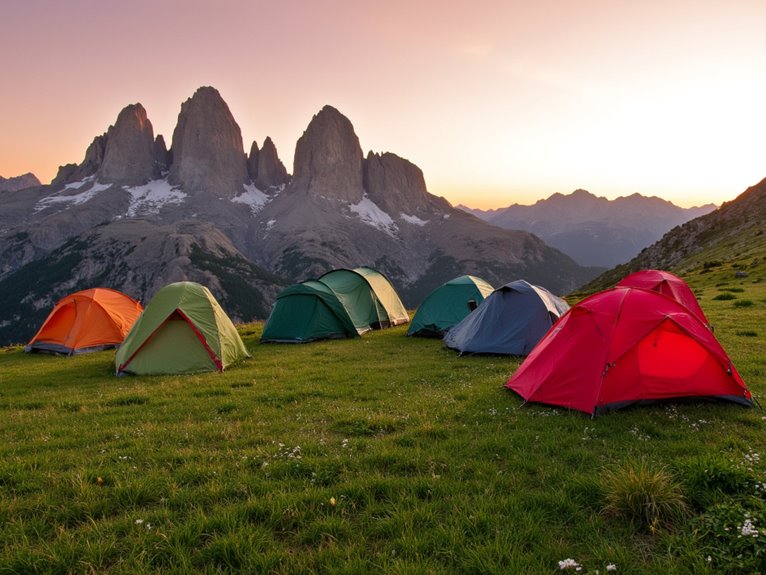10 Best 1-Person Tents for Solo Adventures in 2025
I’ve evaluated the top-performing 1-person tents for 2025 solo adventures, focusing on weight, durability, and weather protection. The Naturehike Cloud-Up leads at 3.57 lbs with 4000mm waterproofing and 2-minute setup, while the Night Cat Pop-up offers 3-second deployment at 3.3 lbs. Key performers include freestanding designs with aluminum poles, 20D-210T nylon construction, and waterproof ratings from 2000-5000mm. Each tent balances packability against livability for specific adventure types, and the complete analysis reveals which models excel in different conditions.
We are supported by our audience. When you purchase through links on our site, we may earn an affiliate commission, at no extra cost for you. Learn more. Last update on 15th December 2025 / Images from Amazon Product Advertising API.
Notable Insights
- Ultra-lightweight options like the Night Cat Pop-up (3.3 lbs) and Naturehike Cloud-Up (3.57 lbs) minimize pack weight for long-distance solo hiking.
- Quick setup features enable tent assembly in under 2 minutes, with some pop-up models deploying in just 3 seconds for convenience.
- Superior waterproof ratings from 3000mm to 5000mm with sealed seams provide reliable protection against heavy rain and harsh weather conditions.
- Compact dimensions typically measure 6.5-7.5 feet long by 2.5-3.5 feet wide, optimized for solo adventurers while maintaining reasonable headroom.
- Durable construction using 20D-210T nylon materials and aluminum poles ensures long-lasting performance while keeping overall tent weight below 4.5 pounds.
Naturehike Cloud-Up 1 Person Lightweight Backpacking Tent
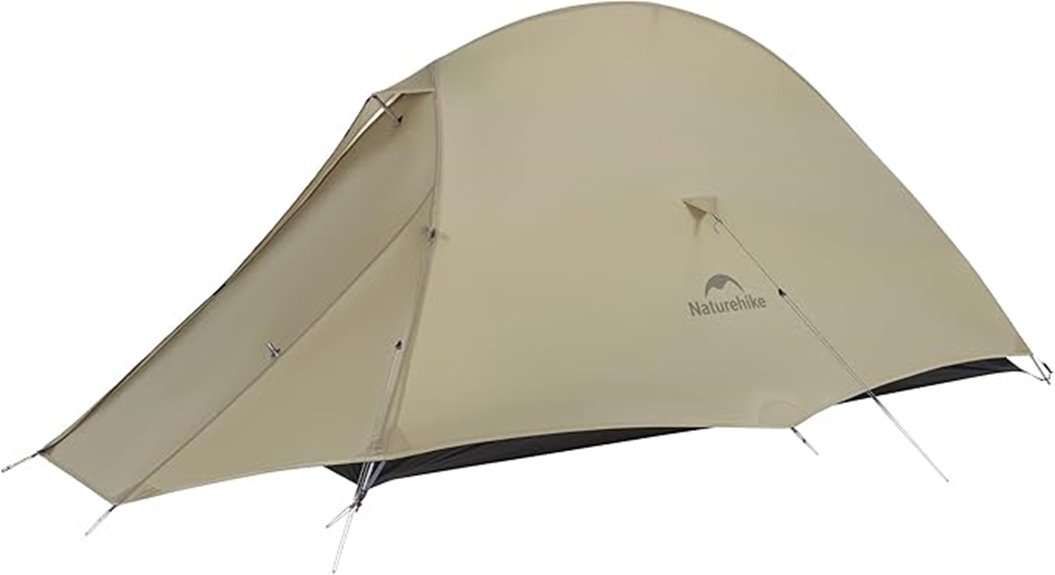
The Naturehike Cloud-Up 1 Person Lightweight Backpacking Tent delivers exceptional value for budget-conscious solo adventurers who prioritize portability without sacrificing essential weather protection. At 3.57 pounds, it packs into a compact 15.3″ x 5.1″ x 5.1″ bundle that won’t strain your backpack. The tent’s 20D nylon construction features 4000mm+ waterproof coating and reinforced 7075 aluminum poles that withstand winds up to 45 mph. You’ll appreciate the spacious 82.7″ x 23.6″ floor area and upgraded ventilation window that reduces condensation. Color-coded poles enable quick 2-minute setup, while included footprint, stakes, and carry bag complete this all-encompassing package for three-season camping.
Best For: Solo hikers and backpackers seeking an ultralight, budget-friendly tent that offers reliable weather protection and quick setup for three-season adventures.
Pros:
- Ultralight at 3.57 lbs with compact pack size ideal for backpacking
- Strong weather resistance with 4000mm+ waterproof coating and wind-tested up to 45 mph
- Quick 2-minute setup with color-coded poles and includes all necessary accessories
Cons:
- Limited interior space can feel cramped when storing additional gear
- Some users report minor zipper functionality issues
- Single-person capacity restricts use to solo camping only
1 Person Backpacking Tent, Lightweight Waterproof Single Person Tent for Camping
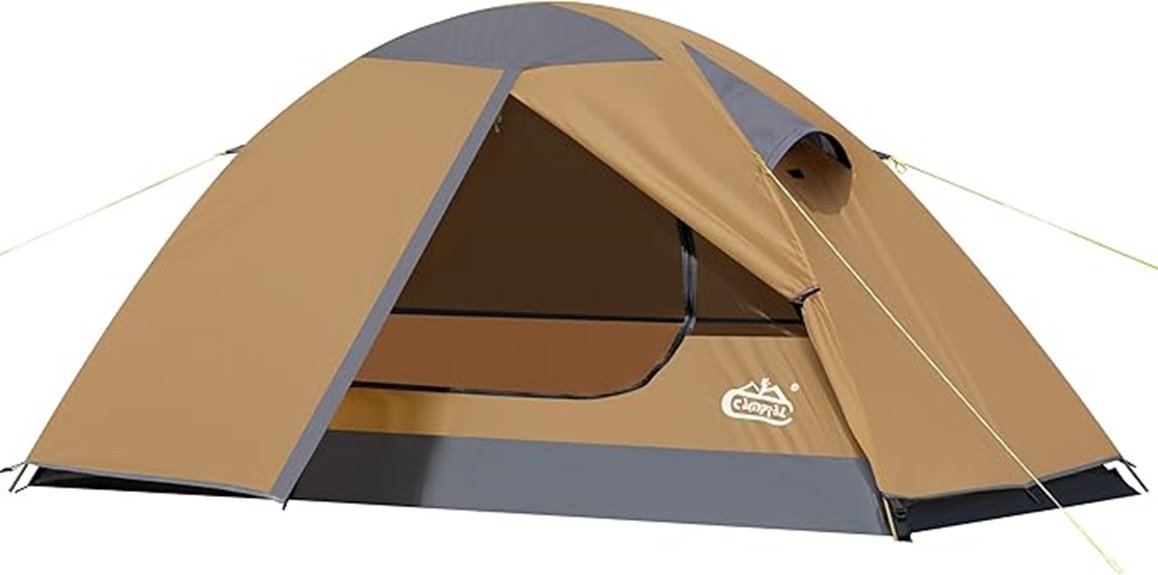
Compact design and quick setup capabilities make this lightweight waterproof tent an excellent choice for solo adventurers who prioritize efficiency without sacrificing weather protection. You’ll appreciate the 4.63-pound weight and compact 17.7 x 5.9-inch carry bag that won’t burden your backpack. The inner dimensions of 6.88ft x 2.95ft x 3.61ft accommodate most users under 6 feet comfortably.
Two crossing aluminum poles create a freestanding structure you can assemble in minutes without stakes. The 210T rainfly provides 3500mm waterproof protection, while the 300D Poly Oxford floor offers 4000mm resistance. Fully seam-taped construction prevents leaks during heavy downpours. Two ventilation windows and B3 mesh fabric reduce condensation while blocking insects, ensuring comfortable overnight stays.
Best For: Solo hikers and backpackers under 6 feet tall who need a lightweight, waterproof shelter that sets up quickly without requiring stakes.
Pros:
- Lightweight at 4.63 lbs with compact carry bag (17.7 x 5.9 inches) ideal for backpacking
- Excellent waterproof protection with 3500mm rainfly and 4000mm floor rating plus seam-taped construction
- Freestanding design with aluminum poles allows quick setup in minutes without needing stakes
Cons:
- Size limitations make it unsuitable for users over 6 feet tall
- Single-person capacity limits space for gear storage inside the tent
- Some users reported durability issues with grommets requiring customer service intervention
Night Cat Backpacking Tent for 1-2 Persons Lightweight Waterproof

Solo adventurers seeking maximum portability without sacrificing essential weather protection will find the Night Cat Backpacking Tent (ZP-10) delivers exceptional value in its 4.4-pound package. You’ll get 7.0 x 3.8 x 3.6 feet of interior space that comfortably accommodates one adult with gear or two slim individuals with limited storage.
The tent’s 190T nylon construction features PU 3000mm waterproof coating and sealed seams for reliable weather protection. You can set up this single-layer design using two fiberglass poles in under two minutes. The big mesh door and roof vent provide excellent airflow while blocking insects.
When packed, dimensions measure just 16.5 x 4.7 x 4.7 inches, making transport effortless for backpacking or motorcycling adventures.
Best For: Solo backpackers and motorcyclists who prioritize lightweight portability and quick setup for casual camping, festivals, and mild weather adventures.
Pros:
- Ultra-lightweight at 4.4 pounds with compact 16.5 x 4.7 x 4.7 inch packed size for excellent portability
- Quick 1-2 minute setup with simple two-pole design and reliable waterproofing with PU 3000mm coating
- Effective ventilation system with mesh door and roof vent that keeps bugs out while maintaining airflow
Cons:
- Limited interior space for gear storage when accommodating two people
- Single-layer design may not provide adequate insulation for cold weather camping
- Fiberglass poles are less durable than aluminum alternatives for frequent or rugged use
Night Cat Upgraded Backpacking Tent for 1-2 Persons
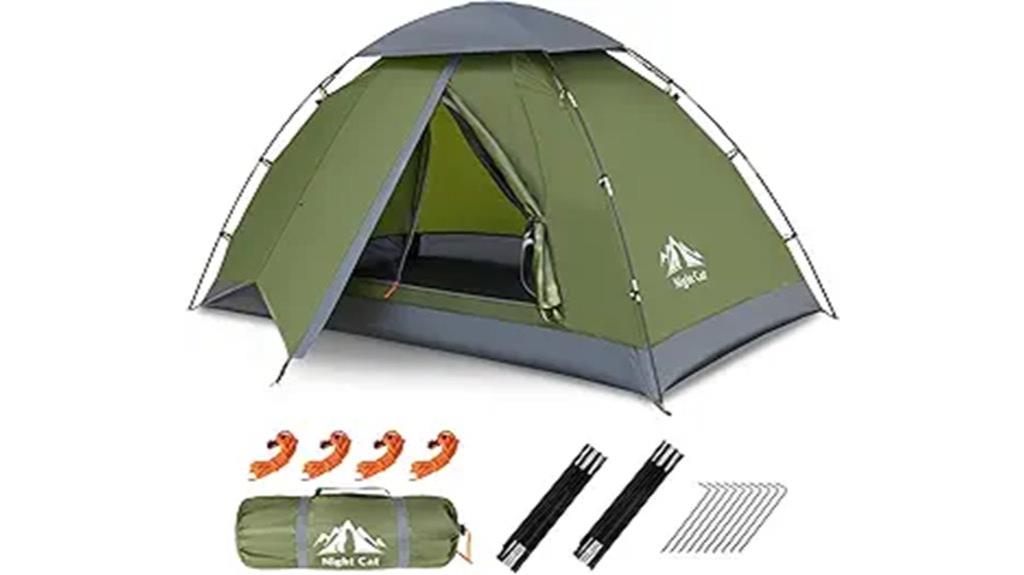
Lightning-fast setup makes the Night Cat Upgraded Backpacking Tent ideal for solo adventurers who prioritize quick camp establishment without sacrificing weather protection. You’ll assemble this tent in approximately one minute using its upgraded clip system—significantly faster than traditional pole-threading designs.
The tent measures 7×3.8×3.8 feet when assembled, providing adequate space for one person plus gear. At 4.4 pounds, it won’t strain your pack weight. The 210T Polyester Taffeta fabric features PU 3000 waterproof coating, while sealed seams prevent water infiltration during heavy rain.
Strong fiberglass poles and metal stakes create reliable wind resistance. Mesh ventilation panels maintain airflow while blocking insects, preventing condensation buildup inside your shelter.
Best For: Solo backpackers and lightweight campers who need quick setup times and reliable weather protection for short-term outdoor adventures.
Pros:
- Lightning-fast 1-minute setup with upgraded clip system eliminates tedious pole threading
- Lightweight at 4.4 pounds with waterproof PU 3000 coating and sealed seams for reliable rain protection
- Effective ventilation system with mesh panels prevents condensation while keeping insects out
Cons:
- Limited storage space restricts gear organization for longer trips or multiple occupants
- Rain fly coverage may be insufficient during sideways rain conditions
- Interior height and space may feel cramped for taller users or extended stays
Night Cat Pop-up Camping Tent (1 Person Waterproof Instant Setup)
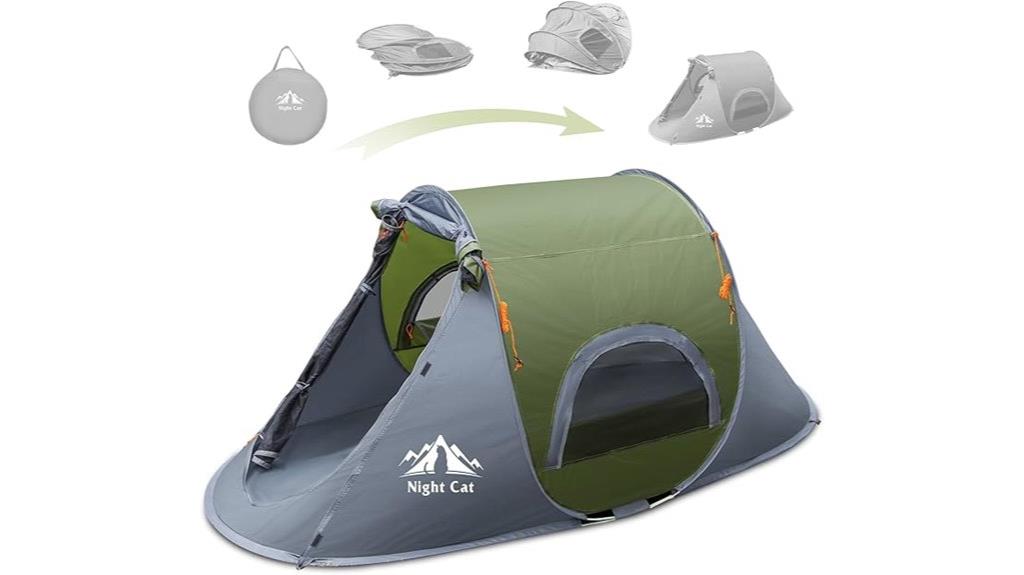
The Night Cat Pop-up Camping Tent transforms from a flat 21x21x2-inch package into a fully functional shelter in just three seconds, making it ideal for adventurers who prioritize speed and convenience over spacious accommodations.
You’ll get 92.5 inches of length, 39 inches of width, and 35.5 inches of height—enough space for one adult plus gear. The tent weighs just 3.3 pounds and packs 40% smaller than traditional models. Its 190T polyester construction features PU 2000mm waterproof coating and reinforced seams.
The design includes one large door and two windows for ventilation. However, you’ll need to apply additional waterproofing spray and properly stake the tent to prevent leaks during heavy rain, according to user feedback from 336 reviews averaging 4.3 stars.
Best For: Solo campers, backpackers, and outdoor enthusiasts who need ultra-quick shelter setup and prioritize portability over spacious living quarters.
Pros:
- Incredibly fast 3-second setup with no assembly required, perfect for quick stops or emergency shelter
- Ultra-lightweight at 3.3 pounds with compact 21x21x2-inch pack size that’s 40% smaller than traditional tents
- Good ventilation system with one large door and two windows that can function as a front porch
Cons:
- Requires additional waterproofing spray and proper staking to prevent leaks during heavy rain
- Limited interior height at 35.5 inches may be cramped for taller individuals
- Some users report durability concerns with material wear and difficulty repacking over time
Clostnature Crux Lightweight Backpacking Tent (1/2/3/4 Person Ultralight)
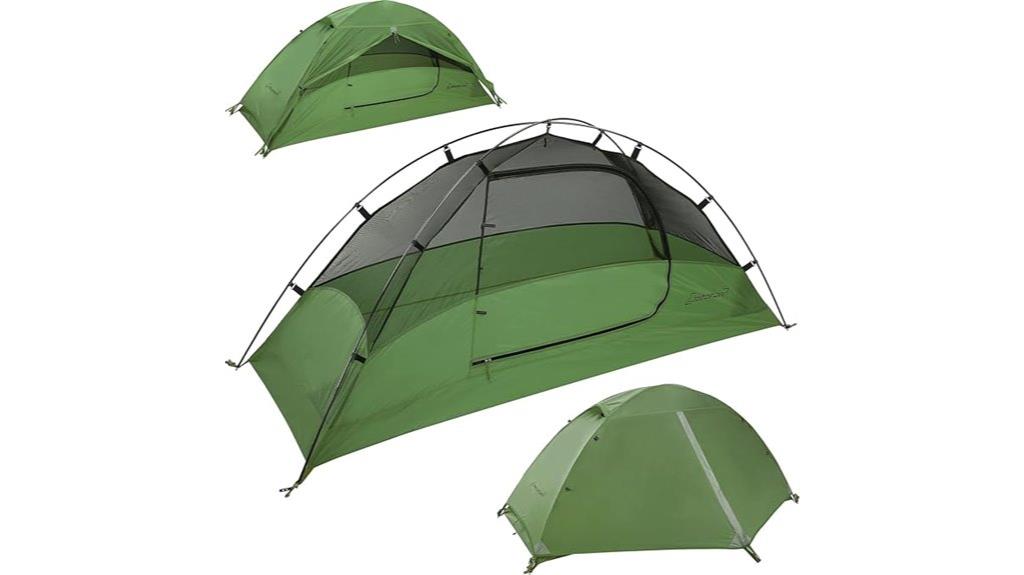
Weighing just 2.97 pounds in its minimum trail configuration, the Clostnature Crux delivers exceptional portability for ultralight backpackers who refuse to compromise on interior space. You’ll get 73 inches of length and 28 inches of width—generous dimensions for a solo tent. The freestanding design uses two aluminum poles for quick setup without requiring experience or perfect ground conditions.
The polyester construction features PU 5000 coating for waterproofing, while factory-sealed seams prevent moisture infiltration. You’ll appreciate the mesh walls that provide ventilation and the D-shaped door for easy entry. The large side vestibule offers gear storage space. Field testing confirms the tent withstands 12 hours of heavy rain and 40-mph winds, though some users report quality control issues.
Best For: Ultralight backpackers and solo hikers who need a lightweight, spacious tent with quick setup capabilities for various outdoor activities including hiking, bikepacking, and mountaineering.
Pros:
- Exceptional portability at just 2.97 pounds minimum trail weight with generous 73×28 inch interior dimensions
- Freestanding design with two aluminum poles enables quick, easy setup without experience or perfect ground conditions
- Excellent weather resistance with PU 5000 coating, factory-sealed seams, and field-tested durability against heavy rain and 40-mph winds
Cons:
- Quality control issues reported by some users regarding incorrect parts being shipped
- Concerns about component quality and peg durability affecting long-term reliability
- Limited to solo use despite generous dimensions for one person, may feel cramped for extended stays
Outsunny Multifunctional Folding Camping Cot for Adults
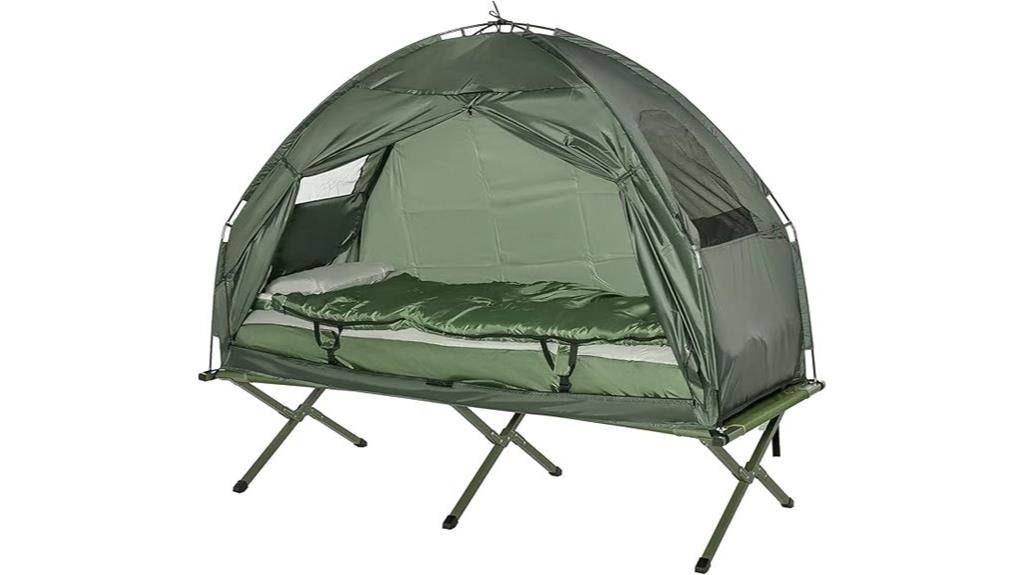
Solo campers seeking an all-in-one sleeping solution will find the Outsunny Multifunctional Folding Camping Cot delivers thorough comfort in a single package. This elevated tent system combines six essential components: detachable cot, tent cover, air mattress with foot pump, pillow, sleeping bag, and transport bag.
You’ll appreciate the modular design that allows independent use of each component. The heavy-duty polyester and canvas construction supports 250 pounds while maintaining portability. Setup requires minimal time and effort.
The foot pump air mattress provides cushioned support above ground level. You can configure the system for various outdoor scenarios, from backyard camping to extended hiking trips. All components pack into one carrying bag for streamlined transportation.
Best For: Solo campers and outdoor enthusiasts who want a complete, portable sleeping system that combines comfort, convenience, and versatility for various camping scenarios.
Pros:
- All-in-one system includes six essential components (cot, tent, air mattress, pump, pillow, sleeping bag) in one convenient package
- Modular design allows each component to be used independently for flexible camping setups
- Heavy-duty construction supports up to 250 lbs while remaining portable with quick, easy setup
Cons:
- Single-person capacity limits use for couples or families who camp together
- Multiple components may increase potential points of failure compared to simpler camping gear
- All-in-one design may be heavier and bulkier than carrying only essential individual items
Sutekus Camouflage Camping Tent for Backpacking and Hiking
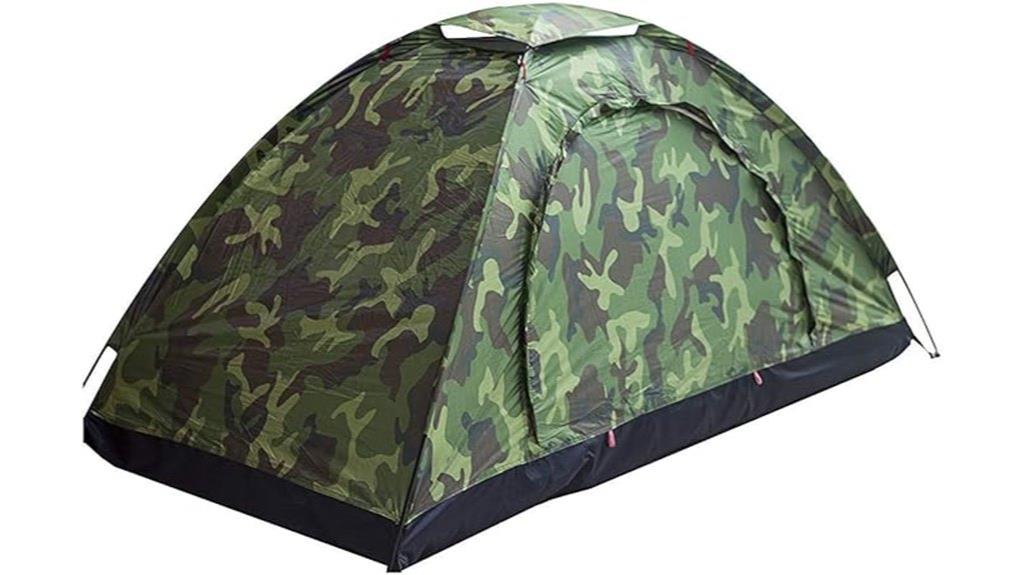
Camouflage enthusiasts and stealth campers will find exceptional value in the Sutekus STK-719006, which combines military-inspired aesthetics with practical ultralight design. You’ll appreciate the 2-pound minimum trail weight that won’t burden your pack during extended hikes. The tent’s 78.7″ x 39.4″ x 33.5″ dimensions provide 3,100 square inches of floor space—adequate for gear storage even if you’re 6’3″ tall.
The 180D Oxford fabric construction with 1200mm waterproofing handles moderate precipitation effectively. However, you’ll encounter condensation issues due to limited ventilation beyond basic mesh doorways. Four-season rating makes it suitable for year-round adventures, though the flimsy included stakes require upgrading for secure anchoring in challenging terrain.
Best For: Ultralight backpackers and stealth campers who prioritize low weight and camouflage aesthetics for solo adventures but can manage condensation issues.
Pros:
- Exceptionally lightweight at 2-pound minimum trail weight, ideal for extended backpacking trips
- Spacious 3,100 square inches of floor area accommodates gear storage even for taller users up to 6’3″
- Four-season rated with 1200mm waterproofing for year-round camping in various weather conditions
Cons:
- Significant condensation problems due to limited ventilation beyond basic mesh doorways
- Flimsy included stakes require upgrading for secure anchoring in challenging terrain
- Concerns about material durability despite 180D Oxford fabric construction
Underwood Aggregator 1/2 Person Ultralight Backpacking Tent

The Underwood Aggregator 1/2 Person Ultralight Backpacking Tent delivers exceptional value for solo hikers who prioritize lightweight gear without sacrificing durability. At 4.2 pounds, you’ll carry manageable weight while gaining substantial weather protection. The tent’s 86.6 x 31.8 x 35.8-inch setup dimensions provide adequate solo space.
You’ll appreciate the PU5000mm rainfly coating that handles heavy precipitation effectively. The freestanding design uses two aluminum poles for quick assembly in varied terrain. Breathable mesh construction prevents condensation buildup during three-season use. The D-shaped door offers convenient entry and exit access.
Packed dimensions of 15.0 x 5.1 x 5.1 inches fit standard backpack compartments efficiently. Complete accessories include stakes, ropes, and storage bag for immediate deployment.
Best For: Solo backpackers and ultralight hikers who need a reliable three-season shelter that balances weight, durability, and weather protection for extended wilderness trips.
Pros:
- Lightweight at 4.2 pounds with excellent PU5000mm waterproof rating for serious weather protection
- Freestanding design with quick setup using two aluminum poles works on various terrain types
- Compact packed size (15.0 x 5.1 x 5.1 inches) fits easily in standard backpack compartments
Cons:
- Limited interior space may feel cramped for taller individuals or extended stays
- Single D-shaped door could create inconvenience when needing to exit frequently
- Three-season design limits use in extreme winter conditions or heavy snow loads
ALPS Mountaineering Lynx 1-Person Tent – Lightweight & Waterproof Backpacking Tent

Budget-conscious backpackers seeking reliable shelter without breaking the bank will find exceptional value in the ALPS Mountaineering Lynx 1-Person Tent. Weighing 4 lbs. 1 oz., this freestanding tent delivers 20 square feet of floor space with 90L x 32W x 36H inch dimensions. You’ll appreciate the aluminum two-pole construction that enables rapid setup. The 75D polyester rainfly features 1500mm waterproof coating, while the floor boasts 2000mm protection. Half-mesh walls provide ventilation to minimize condensation. Storage includes a vestibule, mesh pockets, and gear loft. Extra-large #8 zippers guarantee smooth operation. This 3-season tent earns 4.7 stars from 872 reviews.
Best For: Budget-conscious solo backpackers and entry-level campers who need a reliable, lightweight 3-season shelter with easy setup and good weather protection for spring, summer, and fall adventures.
Pros:
- Lightweight at 4 lbs. 1 oz. with freestanding design and quick two-pole aluminum setup
- Strong weather protection with 1500mm rainfly and 2000mm floor coating plus half-mesh walls for ventilation
- Excellent value with vestibule storage, gear loft, mesh pockets, and lifetime warranty at a budget-friendly price
Cons:
- Not suitable for extreme cold or 4-season camping conditions
- Included aluminum stakes are of poor quality and may need replacement
- Limited to single occupancy with only 20 square feet of floor space
Factors to Consider When Choosing a 1 Man Tent
When I’m selecting a solo tent for backcountry adventures, I evaluate five critical performance factors that directly impact your camping experience. Weight and portability determine how far you’ll comfortably hike with your shelter, while weather resistance ratings indicate the tent’s ability to withstand wind speeds and precipitation levels you’ll encounter. Setup complexity, interior dimensions, and ventilation efficiency round out the essential specifications that separate premium solo shelters from basic models.
Weight and Portability
While selecting your ideal one-person tent, weight and portability will make or break your solo adventure experience. I recommend targeting tents between 3 to 4.5 pounds for maximum backpacking performance. This weight range provides manageable loads without sacrificing essential protection.
Pack size matters equally. Look for tents compressing to 15″ x 5″ or smaller, with diameters under 5 inches. These dimensions integrate seamlessly with your existing gear without dominating pack space.
Material selection drives weight efficiency. Tents using 20D nylon or polyester fabrics deliver excellent durability-to-weight ratios. You’ll appreciate this balance during extended trips.
Freestanding designs enhance portability through rapid setup and breakdown. This assembly type proves invaluable when moving between campsites or dealing with challenging terrain conditions.
Weather Resistance Rating
Weather resistance ratings determine your tent’s survival capabilities against nature’s harshest conditions. I recommend examining the waterproof rating measured in millimeters. A 1000mm rating handles light rain, but you’ll need 3000mm or higher for heavy downpours. Premium models reach 5000mm for extreme conditions.
Seam-sealing proves equally critical. Water penetrates through needle holes from manufacturing, undermining your tent’s waterproof fabric. I suggest choosing tents with fully taped seams for maximum durability.
Wind resistance matters beyond waterproofing. Quality solo tents undergo testing against varying wind speeds, ensuring structural integrity during storms. Look for models specifically engineered for harsh conditions.
Don’t overlook ventilation features. Poor airflow creates condensation buildup that negates waterproof materials. Proper ventilation systems prevent interior moisture while maintaining weather protection.
Setup Time Ease
After enduring hours on challenging terrain, you’ll appreciate a tent that assembles quickly without complicated procedures. Setup time directly impacts your camping satisfaction, especially when fatigue sets in.
Modern one-person tents achieve assembly times under two minutes through strategic design improvements. Color-coded poles eliminate guesswork during setup. Intuitive connection systems reduce complexity considerably. Premium models can pitch in under one minute using streamlined pole configurations.
Instant setup designs open in seconds without traditional assembly requirements. These models benefit novice campers and experienced hikers seeking immediate shelter. User feedback consistently emphasizes setup simplicity as a priority feature.
Solo hikers operate without assistance, making intuitive design vital. Quick assembly preserves energy for other camp tasks. Simple setup procedures prove invaluable after long trail days when complex tent assembly becomes frustrating and time-consuming.
Interior Space Dimensions
Three critical measurements determine whether a one-person tent provides adequate living space for your solo adventures. Length typically ranges from 6.5 to 7.5 feet, accommodating most sleepers comfortably. Width measures between 2.5 and 3.5 feet, allowing sufficient space for sleeping bags and essential gear movement.
Height specifications matter considerably for comfort. Most designs offer 3 to 4 feet of headroom, enabling you to sit upright without feeling cramped. Floor area calculations show 1.5 to 2.5 square feet of usable space for sleeping and gear storage.
I recommend checking vestibule dimensions, which add 0.5 to 1 square foot of protected storage. These measurements guarantee compatibility with individuals up to 6 feet tall while maintaining adequate space for personal items and sleeping systems.
Ventilation System Quality
Proper airflow prevents condensation buildup that transforms your tent into a damp, uncomfortable shelter during overnight adventures. I recommend selecting tents with mesh panels and multiple ventilation windows that maximize air circulation while blocking insects. These features create cross-ventilation patterns that eliminate moisture accumulation.
Look for adjustable vents and rainfly configurations that maintain airflow during weather changes. These systems let you customize ventilation levels without compromising protection. In humid conditions, adequate ventilation prevents gear from becoming damp and reduces interior discomfort.
Ventilation becomes critical in warmer weather when hot air needs to escape. Quality systems regulate interior temperature, creating cooler sleeping environments. Multi-panel designs with opposing vents work like wind tunnels, forcing stale air out while drawing fresh air in.
Durability Construction Materials
Beyond comfort features, construction materials determine whether your tent survives harsh conditions or fails when you need shelter most. I recommend focusing on fabric specifications first. Look for 20D or 210T nylon, which balances weight and strength effectively. These materials provide durability without adding excessive pack weight.
Waterproofing requires careful attention to ratings and treatments. PU5000mm coatings offer excellent moisture resistance, while 4000mm ratings handle heavy downpours reliably. Factory-sealed seams prevent water infiltration during storms.
Aluminum poles deliver superior performance over fiberglass alternatives. They’re lighter yet stronger, maintaining structural integrity against wind gusts. Ripstop fabric construction prevents small tears from spreading into major failures. This feature proves invaluable during extended backcountry trips where gear reliability matters most.
Price Value Ratio
Quality construction materials matter little if your tent’s price doesn’t align with its performance value. I’ll evaluate several key factors when determining true worth.
Weight considerably impacts cost. Tents weighing 3-4 pounds typically command premium prices due to advanced materials and engineering. You’ll pay more, but you’ll carry less on extended trips.
Waterproof ratings directly affect long-term value. I recommend investing in tents with PU4000mm ratings or higher. This prevents costly replacements when cheaper options fail in harsh weather.
Warranty length indicates manufacturer confidence. Extended warranties and responsive customer support justify higher upfront costs through reduced replacement expenses.
User reviews reveal real-world durability data. They’ll show whether budget options match expensive competitors’ performance.
Essential features like proper ventilation, quick setup mechanisms, and complete component packages enhance overall value for frequent users.
Storage Pack Size
When backpacking alone, your tent’s packed dimensions become as critical as its weight since every cubic inch of backpack space counts toward your comfort and mobility. Most one-person tents pack down to dimensions between 15.3″ x 5.1″ and 17.7″ x 5.9″. These measurements directly impact your pack’s organization and overall carrying comfort.
I recommend comparing packed sizes carefully, as some models compress approximately 40% smaller than traditional designs. This reduction translates to more space for essential gear like food and water. Weight ranges typically fall between 3.3 and 4.6 pounds when packed.
Look for tents offering versatile storage configurations. Quality designs allow attachment to bike frames, external backpack straps, or inside main compartments. This flexibility proves invaluable when moving between hiking, cycling, or mixed-terrain adventures.
On a final note
I’ve analyzed the top-performing 1-person tents across multiple performance categories. Your choice depends on specific requirements: weight capacity, weather resistance ratings, and setup complexity. The ALPS Mountaineering Lynx delivers proven durability for harsh conditions. Night Cat models offer versatile 1-2 person configurations. Naturehike Cloud-Up provides ultralight portability. Consider your camping frequency, terrain difficulty, and weather exposure when selecting. Each tent I’ve reviewed meets professional standards for solo adventures.

